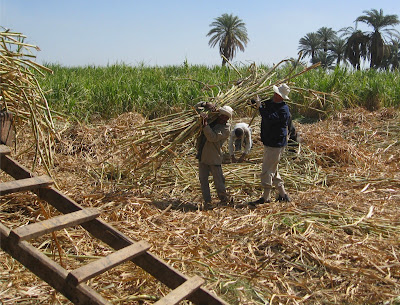
After an Egyptian breakfast of omelet, fuul (baked beans), (sun-risen) shamsi bread, apricot marmalade and coffee with our friends at their rustic 'pensione' near Madinat Habu, the Time Traveller and I took a circuitous route home, exploring new paths. Alongside a small canal I spotted a
shadouf.
Shadouf appear in pharaonic tomb paintings and were common up to 20 years ago, but are a rare sight these days. This irrigation tool lifts water from the canal into field irrigation trenches using a rubber sack. At the other end of the cantilever pole is a mud weight that helps the farmer lift the water, but it's still back-breaking work.
And speaking of pharaohs, that mound in the background is manmade. It is one of many massive mounds that the Pharaoh Amenhotep III had built of earth to create a large lake at the entry to his palace. The mounds stretch for 2.5 km (North-South) by about 2 km (East-West). What an ego! The palace site is called Malqata. The Metropolitan Museum of Art excavated here in the early 1900s (we saw one of the great excavation trenches going through a mound) and it has returned in the last few years to continue exploration. Check out their excavation
blog.

A little further along the canal was a
sakkia. This is an iron version of the old wooden waterwheel with attached buckets that would hoist water up into the fields as a donkey walked in circles.

And yet a little further, on the opposite side of the canal where the fields are much larger, two diesel pumps were spewing many liters of water per minute into the irrigation trenches. Although more efficient and much less back-breaking, they make a horrible racket in the otherwise peaceful countryside.

Back at home, the work crew had removed the cut cane from the field beside our flat. I miss the green, but I'm sure new sprouts will soon appear.





























































